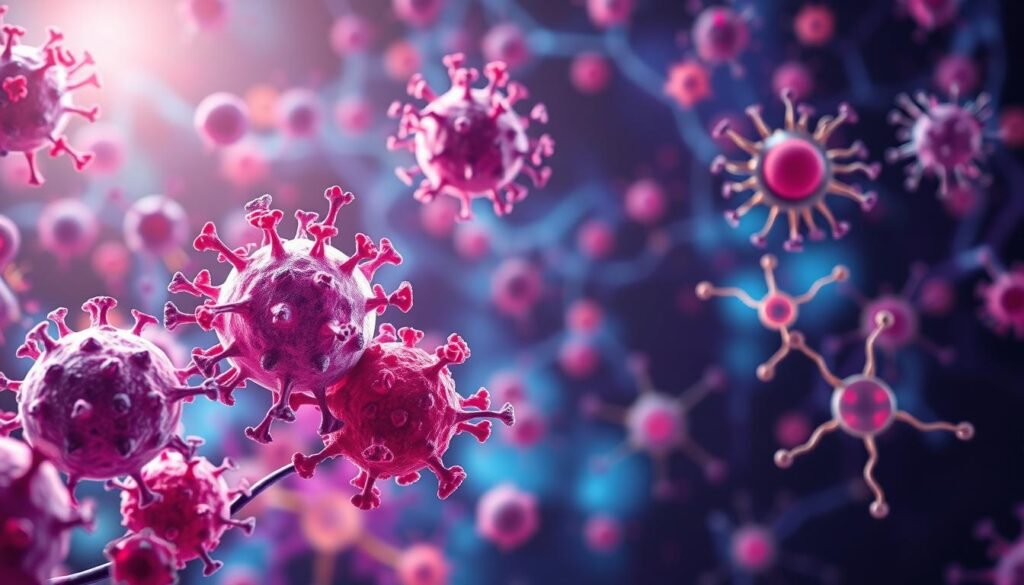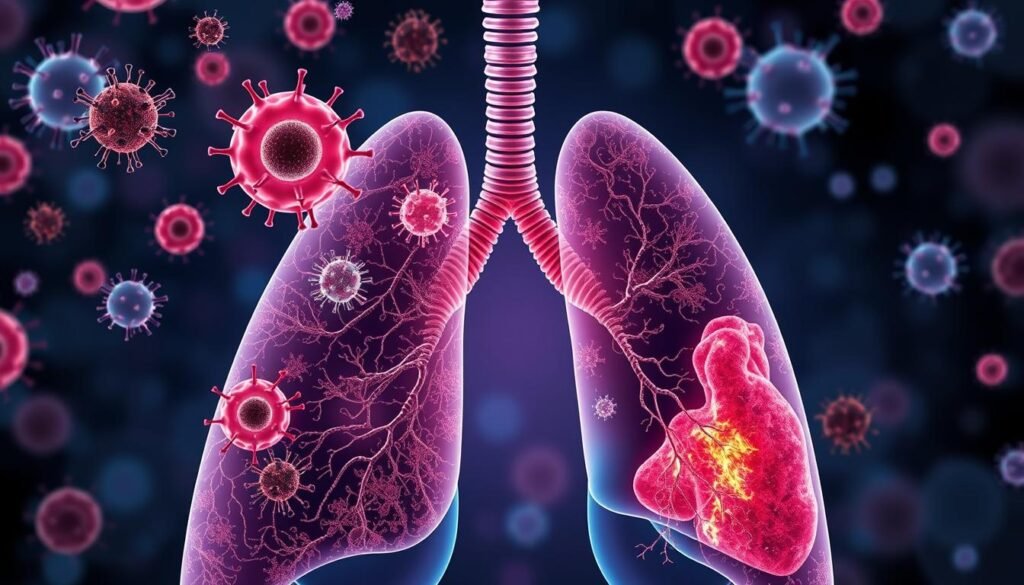Did you know in the ADRIATIC trial, over 57% of people taking durvalumab were still alive after three years? This is compared to just 48% who received a placebo. This statistic is very important. It shows how immunotherapy can fight small cell lung cancer (SCLC). This kind of treatment uses our immune system to fight this tough disease. For more than 30 years, SCLC treatment didn’t change much. It mostly involved chemotherapy and radiation.
But now, with immunotherapy, there’s new hope. Drugs like durvalumab and atezolizumab are leading the way. This article will explain how immunotherapy for SCLC works. We will look at different types of these treatments and their success in helping patients live longer.
Key Takeaways
- Immunotherapy represents a significant advancement in treating small cell lung cancer.
- Drugs like durvalumab and atezolizumab show promising results in improving survival rates.
- FDA-approved treatments expand options beyond traditional therapies for SCLC.
- Clinical trials continue to explore combination therapies and personalized treatments.
- Immunotherapy works by training the immune system to recognize and destroy cancer cells.
Understanding Small Cell Lung Cancer
Small cell lung cancer (SCLC) makes up about 15 percent of all lung cancers. It is very aggressive. It mostly affects smokers, including those who used to smoke a lot. SCLC has two stages: limited stage, in one lung or half the chest, and extensive stage, where it spreads.
It’s crucial to spot the symptoms of small cell lung cancer early. Symptoms include coughing, breathlessness, chest pain, and losing weight. Tests like CT scans, biopsies, and sputum cytology are used for diagnosis. This helps doctors specializing in lung diseases create effective treatment plans, which could include chemotherapy and radiation.
Immunotherapy is now a key treatment for SCLC, especially in improving survival for extensive stage patients. Treatments like Atezolizumab or durvalumab are added to the treatment plan. Along with chemotherapy, given through an IV every three weeks, these therapies represent a big leap in treating SCLC.
The side effects from SCLC treatments like chemotherapy and radiation can be tough. Chemotherapy might cause tiredness, hair loss, and feeling sick, while radiation can result in painful swallowing and more coughing. It’s important to manage these side effects to keep a good quality of life during treatment.
Understanding small cell lung cancer deeply is key to exploring new treatments and better outcomes for patients. Comprehensive care includes treating the cancer and considering the overall health impacts. For more about small cell lung cancer, check out this resource. To learn about immunotherapy, click here.
What is Immunotherapy?
Cancer immunotherapy is a modern way to help the body fight cancer. It uses the body’s own immune response. This method is different from traditional treatments like chemotherapy. It works by using medicines that help the immune system find and destroy cancer cells better.
This approach has become more popular, especially after new laws focused on research for hard-to-treat cancers like small cell lung cancer (SCLC). These laws support finding better treatments.
Immunotherapy comes in different forms. One example is targeted therapy with immune checkpoint inhibitors. They block proteins that weaken the immune system. By blocking these proteins, the therapy helps immune cells attack cancer more efficiently. Scientists are always looking for new ways to fight cancer, including vaccines that target SCLC.
To really understand SCLC, we need to see that there are many types of it. Each type has specific markers that may react differently to immunotherapy. Research shows pairing immune checkpoint inhibitors with new drugs like LSD1 inhibitors could be effective. It’s all about finding the right treatment for each person, as everyone’s cancer is different.
Types of Immunotherapy
Immunotherapy is changing how we fight cancer, especially small cell lung cancer (SCLC). We see two main types: immune checkpoint inhibitors and cancer vaccines. They help our immune system find and fight cancer cells.
Immune Checkpoint Inhibitors
Immune checkpoint inhibitors are key in treating SCLC. They stop proteins like PD-1 and PD-L1 from preventing immune attacks on tumors. Drugs such as nivolumab and pembrolizumab boost our immune response to cancer. They’ve shown great results, especially after chemotherapy. This makes these inhibitors vital for fighting aggressive cancer.
Cancer Vaccines
Cancer vaccines are in development but offer exciting possibilities. They aim to train the immune system to attack cancer more efficiently. By targeting cancer-specific proteins, they could bolster our natural defenses. Ongoing research on SCLC vaccines looks promising for better treatments and survival chances. Cancer vaccines could soon play a big role in immunotherapy against SCLC.
Immunotherapy for Small Cell Lung Cancer
Immunotherapy has changed the game for small cell lung cancer (SCLC) treatment. Before, traditional treatments did not do much to increase survival. Now, drugs like atezolizumab (Tecentriq) are used with chemotherapy. This method helps the body’s immune system fight cancer more effectively.
In a study called IMpower133, 400 patients with advanced SCLC took part. Those treated with atezolizumab lived about 12.3 months. This is longer than the 10.3 months for those who received a placebo. The trial also showed that the disease took longer to worsen in the atezolizumab group.
While atezolizumab brings new hope, it also comes with side effects like anemia and neutropenia. It’s important to watch and manage these side effects carefully. Researchers continue to study this treatment to improve life expectancy and quality for lung cancer patients.

| Parameter | Atezolizumab (plus chemotherapy) | Placebo (plus chemotherapy) |
|---|---|---|
| Medial Survival | 12.3 months | 10.3 months |
| Time to Disease Progression | 5.2 months | 4.3 months |
| Common Side Effects | Anemia, Neutropenia | Standard chemotherapy effects |
| Immune-Related Side Effects | Increased | Standard baseline |
FDA-Approved Immunotherapy Drugs
Recent progress in immunotherapy drugs has changed small cell lung cancer (SCLC) treatment. These drugs use the immune system to fight cancer, particularly when other treatments don’t work.
Nivolumab and Pembrolizumab
Nivolumab and Pembrolizumab are leading PD-1 inhibitors for recurring SCLC after chemotherapy. They help the immune system recognize and kill cancer cells better.
Atezolizumab and Durvalumab
Atezolizumab and Durvalumab are PD-L1 inhibitors used with chemotherapy for advanced SCLC. They improve survival rates and slow disease progression, proving crucial in treatment.
Pembrolizumab has a 19% response rate and benefits lasting up to 24 months. This shows its value for fighting this tough disease. For more info on Pembrolizumab, check this link.
| Drug | Type | Overall Response Rate | Dose |
|---|---|---|---|
| Nivolumab | PD-1 Inhibitor | Varies | 3 mg/kg every 2 weeks |
| Pembrolizumab | PD-1 Inhibitor | 19% | 200 mg IV every 3 weeks |
| Atezolizumab | PD-L1 Inhibitor | Varies | 1200 mg IV every 3 weeks |
| Durvalumab | PD-L1 Inhibitor | Varies | 1500 mg IV every 4 weeks |
How Immunotherapy Works in SCLC
Immunotherapy is a breakthrough in fighting small cell lung cancer (SCLC). It boosts the immune system’s power to find and kill cancer cells. These treatments focus on certain proteins that block immune responses. This enables a stronger attack against the cancer.
Only about 15% of all lung cancers are SCLC. It grows fast and spreads quickly, posing big challenges. Immunotherapy is key here, as regular treatments often fall short. Current therapies usually offer less than six months without disease progression. The median survival time after platinum-based chemo is around ten months.
Clinical trials have shown the promise of immunotherapy in extending life. For example, adding Atezolizumab to chemo in the Impower133 trial led to a median survival of 12.3 months. Trials with Durvalumab and chemo pushed survival to 13.0 months. This highlights its success in fighting cancer through the immune system.
SCLC patients often have many mutations, which makes treatment tough. Even so, new therapies combined with chemo are improving survival chances. This approach mixes old and new treatments, bringing new hope where progress was slow.

| Therapy | Median Overall Survival (Months) | Hazard Ratio |
|---|---|---|
| Atezolizumab + Chemotherapy | 12.3 | 0.70 |
| Durvalumab + Chemotherapy | 13.0 | 0.73 |
| Pembrolizumab + Chemotherapy | Not statistically significant | N/A |
| Adebrelimab + Chemotherapy | 15.3 | 0.72 |
| Serplulimab + Chemotherapy | 15.4 | 0.63 |
Combination Therapies
Combination therapies are key in treating small cell lung cancer (SCLC). They mix different treatments to improve outcomes. We see this in the joining of immunotherapy and chemotherapy, and in maintenance therapy after initial treatment.
Immunotherapy with Chemotherapy
Studies show great results when immunotherapy is added to standard chemotherapy for SCLC. Using atezolizumab with chemo drugs like etoposide and cisplatin has been effective. It increases tumor response and helps patients enjoy a better life for a longer time.
Maintenance Therapy
After the first treatment, maintenance therapy plays a vital role for those with advanced SCLC. It uses immune treatments after chemo to keep cancer at bay longer. More and more, this approach is seen as crucial for a comprehensive battle against SCLC.
| Type of Therapy | Description | Benefits |
|---|---|---|
| Immunotherapy with Chemotherapy | Combines immune checkpoint inhibitors with standard chemotherapy agents. | Improved tumor response rates and extended remission. |
| Maintenance Therapy | Focuses on ongoing immunotherapeutic treatment after initial chemotherapy. | Prolonged remission and delayed tumor progression. |
Possible Side Effects of Immunotherapy
Immunotherapy is a key treatment for lung cancer. It’s effective, but we must know the possible side effects. These can be mild or very serious.
Common Side Effects
Many people getting immunotherapy face common side effects. These include:
- Fatigue
- Cough
- Skin rash
- Loss of appetite
- Joint pain
- Nausea
These effects often get better as the body adapts. Knowing them helps patients and doctors work together better.
Serious Side Effects
Immunotherapy is usually well-received, but there can be serious side effects. They might happen if the body reacts strongly. Watch out for:
- Shortness of breath
- Severe fatigue
- Severe skin reactions
Any serious side effects must be told to a doctor right away. Quick action is needed. For more details on handling these, visit this resource.

Clinical Trials and Recent Advances
Ongoing clinical trials are crucial in the battle against small cell lung cancer (SCLC). They mark a shift towards personalized medicine. Noteworthy is the ADRIATIC study, which looks at durvalumab for limited-stage SCLC. Other research is checking out new combo treatments and drugs like tarlatamab.
The IMpower133 and KEYNOTE-604 studies show how adding immune checkpoint inhibitors to chemo improves results. These research studies have shown better survival rates for patients with advanced-stage SCLC. Around 83% of SCLC tumors have DLL3, a key focus in these studies. As immunotherapy gets better, these trials will inform future treatments, leading to better care for SCLC patients.
Conclusion
Immunotherapy is a shining light for those fighting small cell lung cancer (SCLC). This type of cancer makes up about 10% to 15% of lung cancers. Thanks to ongoing studies and treatments approved by the FDA, the outlook for SCLC is getting better. Immunotherapy works by getting the body’s immune system to fight the cancer. This approach is improving how long people live and the options for treatment.
Clinical trials have shown that drugs like atezolizumab and nivolumab can help patients live longer. For example, the IMpower133 study found that adding atezolizumab to chemotherapy increased survival to 12.3 months. This is a big change from older treatments. Those usually offer survival from 8 to 20 months depending on how advanced the cancer is.
The fight against SCLC is changing fast as new treatments are discovered and old ones get better. Studies on drugs like pembrolizumab and atezolizumab as first treatments are promising.
These advances mean a big change in how we treat cancer. They offer not just hope, but real benefits to those fighting cancer. For more details on this exciting area, you can read more here.